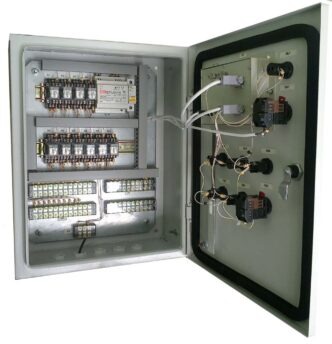Multicomponent dispenser MKD
-
MKD control cabinet:Constant Weight
Multicomponent dispenser MKD – allows you to automate dosing processes and organize accounting of the consumption of dosed materials.
The MKD control cabinet is a device based on the KV4 Weight Indicator. It has inputs for connecting load cells, damper position sensors and additional controls. Up to ten different actuators can be connected to it and controlled according to a programmed algorithm. The main feature of this product is the ability to quickly reprogram the dosing algorithm and the ability to exchange information with a personal computer via the RS-232 or RS-485 interface.
The control cabinet is wall-mounted with protection degree IP54, the indicator panel and the main controls are located on the front side. The appearance of the control cabinet is shown in Figure 1.
Rice. 1 MKD control cabinet
The KV4 weight indicator, which is part of the MKD control cabinet, is equipped with a two-line backlit liquid crystal display, which displays in dosing mode:
- prescription number (for example, Rec4);
- number of doses used (for example, 1234d);
- current dosing step (for example, w0, i.e. the letter “w” and the step number);
- dispenser state(o—stopped, p—working, h—completion, p—pause);
- current component (for example k1);
- the weight of the current component or the total current weight.
The KV4 terminal can exchange data with a top-level automated control system (ACS) or with a personal computer via RS-232 or RS-485 protocol. When using the RS-485 protocol, it is possible to connect up to 31 devices to a computer simultaneously and create a network.
Main features, standard functions and technical characteristics of the MKD control cabinet
Peculiarities
- simplicity and ease of maintenance;
- the ability to quickly reprogram the dosing algorithm;
- exchange of information with a personal computer via RS-232 and RS-485 interface;
- protection from external factors due to powder enamel coating;
- Warranty period – 1 year.
Operating modes
“Autonomous” – dosing with setting parameters using the keyboard;
“Complex” – dosing with setting parameters from the host computer;
“Adjustment” – programming the operating algorithm, performing calibration and adjustment operations.
Standard Features
- automatic control of one-, two- and three-speed component feeders;
- up to six dosed components;
- six recipes stored in the device’s memory;
- counting dosing cycles;
- calculating the total weight of the components and mixture used;
- dispenser control via RS-232 or RS-485 protocol;
- The dosing program and recipes stored in the device’s memory are available for reading and writing via the RS-232 or RS-485 protocol.
| Characteristics | Meaning |
| Supply voltage | 220V, 50Hz |
| Overall dimensions (H,W,D) | 500mm*400mm*200mm |
| Weight, no more | 25 kg |
| Maximum number of load cells connected in parallel | up to 8 400 Ohm sensors |
| Maximum length of communication line with strain gauges | up to 80m (shielded cable) |
| Number of output control signals | 10 |
| Number of external control inputs | 9 |
| Maximum number of steps in a dosing cycle | 32 |
| Maximum quantity of dispensed components | 6 |
| Number of recipes stored in memory | 9 |
 all products
all products

-
Manufacturer:Constant Wes
-
Equipment:Software "Car scales"











 Main office:
Main office:  Phones:
Phones:  Mail
Mail 


